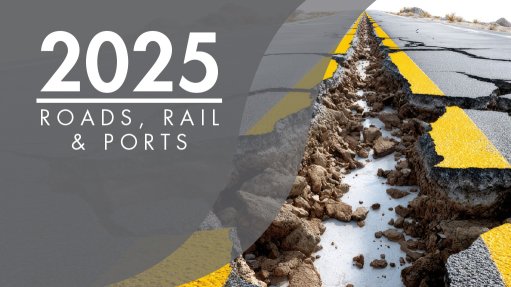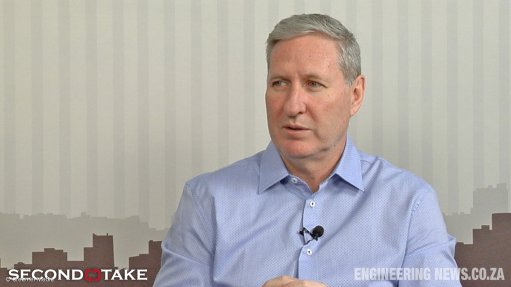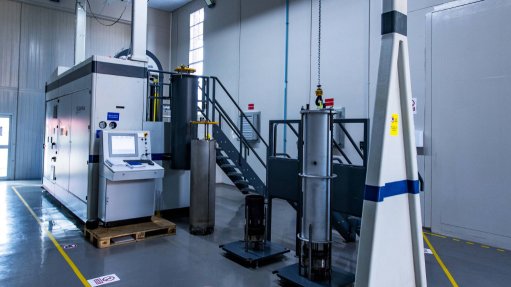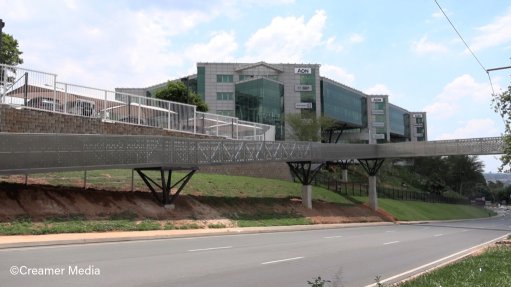South Africa’s small-end diamond producers are battling to survive, Sadpo reports


Sadpo diamond leadership interviewed by Mining Weekly's Martin Creamer. Video: Darlene Creamer.
Sadpo vice-chairperson Lyndon de Meillon.
JOHANNESBURG (miningweekly.com) – South Africa’s small-end diamond producers are battling to survive in a diamond situation in South Africa which is under severe pressure, South African Diamond Producers Organisation (Sadpo) reported on Thursday.
Sadpo chairperson Gert van Niekerk and vice-chairperson Lyndon de Meillon painted a dire picture of the current situation during a Zoom interview with Mining Weekly in which reference was made to blood being on the streets of small South African towns as a result of the global diamond crisis. (Also watch attached Creamer Media video.)
“To ensure that natural diamonds regain their shine, the industry needs to aggressively and cleverly advertise diamonds to the younger generation to embrace the natural source, age and amazing creational history of natural diamonds,” De Meillon urged.
“This means that branding and traceability will become more important as today's consumer is much more conscious of the impact mining has on the environment and on the communities where diamonds are being mined.”
Sadpo was founded 23 years ago to streamline the alluvial diamond industry and to speak on behalf of the smaller end of South Africa’s diamond business.
De Meillon put South Africa’s current drastic carat reduction situation mainly down to price.
“To understand this, we need to go and look at it in a bit more detail,” he pointed out.
This is because the current price crisis in the diamond industry as a whole is partly the industry's own doing, and partly due to external circumstances, unfortunately both combining at the same time to create the perfect storm, driving prices down, probably for the longest period since the Great Depression of the 1930s.
In the early 2000s, De Beers stepped back from its role as curator of the industry, to ensure that it was no longer seen as a monopoly. Then, when it went completely into the Anglo American fold in 2011, the focus on aggressive advertising fell away, “most likely because of the loss of the key experience of the Oppenheimer family”, De Meillon commented.
Other role players in the industry did not step in to fill up the advertising void, even though diamonds are luxury items and consumers have to be continually reminded about why they need them.
At the same time, technological advances meant that larger and better quality laboratory-grown diamonds could be produced.
Initially, consumers were hesitant to accept lab-grown diamonds for emotional privileges like engagements and weddings, but then a couple of things changed.
Pandora announced that they would only be selling lab-grown diamonds in their jewellery, one reason being that it is more environment-friendly to produce diamonds in a laboratory, which is obviously debatable.
Then De Beers launched the Lightbox campaign with their own brand of lab-grown diamonds, something which has since been discontinued.
But in the eyes of the consumer, this gave credibility to lab-grown diamonds, and the sales started to pick up to a point where up to 50% of bridal sales in the US this year could well be from lab-grown stones.
The retail sector also took advantage of this because of the higher margins associated with lab-grown diamonds and actively marketed lab-grown diamonds to consumers.
Of the major external factors that impacted price lately, probably the biggest one in the past 15 years was Covid, when there was a sharp downturn in prices, which also coincided with a sharp reduction in production, as many mines closed for a period.
Then, the strong demand in the month following Covid pushed prices up sharply while supply lagged.
But when the mines stepped up supply, they over-estimated demand.
Moreover, when that production came into the market, the world was caught up in high inflation and high interest rates, combined with increased political instability, “all of which are bad for luxury items”, De Meillon noted.
Also, with the advent of electronic-commerce, the diamond pipeline became considerably shorter.
So, the world is currently sitting with a glut of diamonds in a much shorter pipeline during a period when consumers are severely stressed.
On the South African side, in the smaller diamond mining industry, this impact is proving extremely severe.
As highly cashflow-sensitive price takers, South Africa’s small and junior diamond mining sector is mining ultralow-grade deposits and producing high-value-per-carat diamonds that they cannot afford to stockpile.
Their financial viability is based on selling their diamonds as soon as they extract them.
“They cannot survive the long-term price reduction that we have at the moment,” De Meillon warned.
While the small-end can survive short-term V-shaped fluctuation, diamond prices have been under pressure for more than a year now, and if you look at statistics, the price of smaller than 10.8 ct rough has probably fallen by about 50% since the post-Covid peak.
Some say it might even be more than 50%. Local producers need prices at least 30% above the current level to be able to be profitable.
Historically, the small and junior diamond industry in South Africa were buffered from large price fluctuations by two factors.
Firstly, they produce diamonds from mainly alluvial deposits. The quality of these diamonds are in the top 5% in the world, and owing to their size, they used to be ultra scarce.
“But those of us who have been producing these types of diamonds for the past 15 or 20 years have seen a steady decline in the US dollar per carat price by up to 40% as better recovery techniques were introduced.
“The bottom line is that large, natural, colourless diamonds are not as scarce or rare as they used to be 20 years ago. In addition, lab-grown diamonds can now compete with this production in terms of colour and size and this time around, the South African diamond prices for alluvial production are severely impacted.
“Historically, downturns in the diamond market were associated with worldwide financial instability, and often during those times, the dollar used to strengthen. But this time around, the rand has strengthened against the dollar, and this has exacerbated the situation for local producers, who sell in dollars but incur a large part of their costs in rands.
“These factors, coupled with a regulatory regime in South Africa that is too expensive, as well as persistent high levels of incompetence at local Department of Mineral Resources offices, is combining now to put the industry under pressure and we've seen a lot of companies close down, and we will probably see a lot more close down quite soon,” De Meillon added.
Mining Weekly: What is the employment risk attached to the closure of smaller producers?
Van Niekerk: Figures from 2023 show that the total number of employees in the diamond producing industry in South Africa was around 15 000, and at the smaller end, about 4 500, or 30%, of the total opportunities in the diamond industry. It rests with us producing between 3% and 7% of the carat weight. At this stage, it’s vitally important for us to survive, to keep these jobs available. Most of the areas in which we operate are very remote, and alternative job opportunities are very scarce. Maybe the only alternative employment sector is agriculture, but our employment numbers are much higher than in agriculture, which is why it is so important for us to stay in business.
The present sounds so dire. What is the outlook?
We’ve already seen large producers start to cut production, and if the current price trend continues, there'll definitely be closure of some of the larger mines, so production will drop. As the world's economies start to recover and the middle class in countries such as India and China expand, we'll see demand for natural diamonds recovering again. The price of lab-grown diamonds is also continuing to fall, and probably by next year, we'll be at the level where people will see lab-grown diamonds as being too cheap for emotional or celebratory purchases for engagements or weddings. There will be a recovery but it is difficult to say whether it will be quick enough for our industry. Unfortunately, I suspect that the current price crisis has dented the image of natural diamonds severely. They've lost their image as a good or stable investment due to their scarcity. The question that we have to ask is whether the consumers fundamental perception of natural diamonds has changed. Do younger generation consumers still see natural diamonds as a luxury item bought to celebrate special occasions and milestones, or have lab-grown diamonds tainted this image. The market will recover, but this time around, I think it'll take longer, and it will be a very painful period for everyone involved the industry, which will also require assistance from governments in the countries where diamonds have been mined in the form of the lowering of government royalties and levies on diamond exports, which have a direct impact and an immediate impact on the profitability of companies if those things are reduced. In South Africa, we should also look at zero VAT on diamonds, and also the 5% export levy should be relooked at. We've seen a fundamental pricing shift in the price of colourless diamonds to the lower end of the spectrum. This is a trend that has actually been ongoing for the past eight to ten years, and this will only change once we have a significant drop in worldwide natural diamond production. The market for coloured stones such as pinks and blues and even vivid yellows, will continue to grow steadily, and stay strong as these stones will become even more rare in the future as worldwide production is reduced. It will recover but I think this time, it's a different scenario than we’ve been seeing in the past 20 or 30 years. This time it's going to take a while.
What is Sadpo’s relevance when it comes to all this?
That's the most important part. When the going gets tough, the tough need to get going. During my period as chairman of Sadpo, it has become clear that governing bodies like to talk to an association, and through the Minerals Council South Africa, Sadpo has been able to break down barriers that existed in the past. We need to start lobbying again for our survival. Sadpo is the only organisation that the Department of Mineral Resources acknowledges, and it is important for the world and also the diamond producers to understand the importance of tackling these issues as a unit, because without that, we’re not going to succeed. Sadpo has achieved an attitude change with governing bodies. Through the Minerals Council, we meet quarterly with the chief inspector of mines, where we address a lot of the compliance issues that we have to live with, and that are very expensive. Most of our mine health and safety regulations are written for bigger mines. There's no distinction between what a small alluvial miner has to comply with, if you compare that to a Venetia or a Finsch mine, and we really achieved a good attitude from the relevant bodies through our constant lobbying. That, to us, is the most important part. People have to understand that our organisation is under threat because we are funded by the producers. Therefore, it is so important that we need to keep on taking hands and getting through this as a unit. Forever the optimist, I’m truly expecting a recovery. No one can say when this will take place, but the diamond market has always recovered. But the situation we’re now in makes it difficult for me to see how a large percentage of our members will be able to survive. We need to keep vigilant, to keep on cutting costs where we can, and also keep our employment in place to avoid a catastrophe. In an earlier interview Lyndon gave, he referred to blood being on the streets of the small little towns because of what the diamond industry is going through. But we need to stay positive. Knowing the history, I'm convinced that we will eventually recover. We need to stay in survival mode and do whatever we can to keep on producing.
Article Enquiry
Email Article
Save Article
Feedback
To advertise email advertising@creamermedia.co.za or click here
Comments
Press Office
Announcements
What's On
Subscribe to improve your user experience...
Option 1 (equivalent of R125 a month):
Receive a weekly copy of Creamer Media's Engineering News & Mining Weekly magazine
(print copy for those in South Africa and e-magazine for those outside of South Africa)
Receive daily email newsletters
Access to full search results
Access archive of magazine back copies
Access to Projects in Progress
Access to ONE Research Report of your choice in PDF format
Option 2 (equivalent of R375 a month):
All benefits from Option 1
PLUS
Access to Creamer Media's Research Channel Africa for ALL Research Reports, in PDF format, on various industrial and mining sectors
including Electricity; Water; Energy Transition; Hydrogen; Roads, Rail and Ports; Coal; Gold; Platinum; Battery Metals; etc.
Already a subscriber?
Forgotten your password?
Receive weekly copy of Creamer Media's Engineering News & Mining Weekly magazine (print copy for those in South Africa and e-magazine for those outside of South Africa)
➕
Recieve daily email newsletters
➕
Access to full search results
➕
Access archive of magazine back copies
➕
Access to Projects in Progress
➕
Access to ONE Research Report of your choice in PDF format
RESEARCH CHANNEL AFRICA
R4500 (equivalent of R375 a month)
SUBSCRIBEAll benefits from Option 1
➕
Access to Creamer Media's Research Channel Africa for ALL Research Reports on various industrial and mining sectors, in PDF format, including on:
Electricity
➕
Water
➕
Energy Transition
➕
Hydrogen
➕
Roads, Rail and Ports
➕
Coal
➕
Gold
➕
Platinum
➕
Battery Metals
➕
etc.
Receive all benefits from Option 1 or Option 2 delivered to numerous people at your company
➕
Multiple User names and Passwords for simultaneous log-ins
➕
Intranet integration access to all in your organisation


















